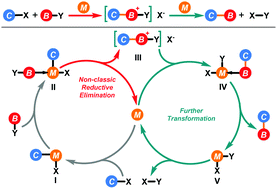当前位置:
X-MOL 学术
›
Chem. Soc. Rev.
›
论文详情
Our official English website, www.x-mol.net, welcomes your feedback! (Note: you will need to create a separate account there.)
Transition-metal-catalyzed reactions involving reductive elimination between dative ligands and covalent ligands.
Chemical Society Reviews ( IF 46.2 ) Pub Date : 2020-01-30 , DOI: 10.1039/c9cs00539k Tianxiao Jiang 1 , Haocheng Zhang , Yongzheng Ding , Suchen Zou , Rui Chang , Hanmin Huang
Chemical Society Reviews ( IF 46.2 ) Pub Date : 2020-01-30 , DOI: 10.1039/c9cs00539k Tianxiao Jiang 1 , Haocheng Zhang , Yongzheng Ding , Suchen Zou , Rui Chang , Hanmin Huang
Affiliation

|
Reductive elimination is a crucial bond-forming elementary reaction in various transition-metal mediated reactions. Apart from the well-developed classic reductive elimination, the non-classic reductive elimination occurring between a covalent ligand and a dative ligand, which has been known for over 50 years, has gradually attracted much attention from the organic community. By avoiding pπ-dπ repulsion between the filled metal d-orbital and the filled ligand p-orbital and forming a cationic-type molecule, non-classic reductive elimination could facilitate many catalytic reactions that were difficult to be realized via classic reductive elimination. In this review, transition-metal catalyzed C-P, C-S, C-N, and C-C bond-forming reactions with non-classic reductive elimination as the key elementary step are summarized.
中文翻译:

过渡金属催化的反应,涉及还原性消除配体配体和共价配体之间。
还原消除是各种过渡金属介导的反应中至关重要的形成键的基本反应。除了发展完善的经典还原消除外,在共价配体和定性配体之间发生的非经典还原消除已经众所周知了50多年,逐渐吸引了有机界的广泛关注。通过避免填充金属d轨道与填充配体p轨道之间的pπ-dπ排斥并形成阳离子型分子,非经典还原反应可以促进许多经典的还原反应难以实现的催化反应。在这篇综述中,总结了过渡金属催化的CP,CS,CN和CC键形成反应,并将非经典还原消除作为关键的基本步骤。
更新日期:2020-03-09
中文翻译:

过渡金属催化的反应,涉及还原性消除配体配体和共价配体之间。
还原消除是各种过渡金属介导的反应中至关重要的形成键的基本反应。除了发展完善的经典还原消除外,在共价配体和定性配体之间发生的非经典还原消除已经众所周知了50多年,逐渐吸引了有机界的广泛关注。通过避免填充金属d轨道与填充配体p轨道之间的pπ-dπ排斥并形成阳离子型分子,非经典还原反应可以促进许多经典的还原反应难以实现的催化反应。在这篇综述中,总结了过渡金属催化的CP,CS,CN和CC键形成反应,并将非经典还原消除作为关键的基本步骤。



























 京公网安备 11010802027423号
京公网安备 11010802027423号